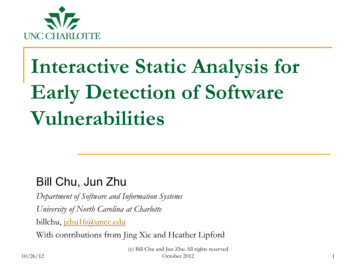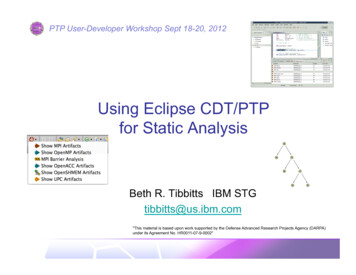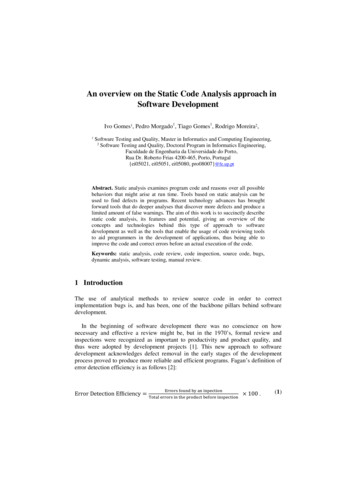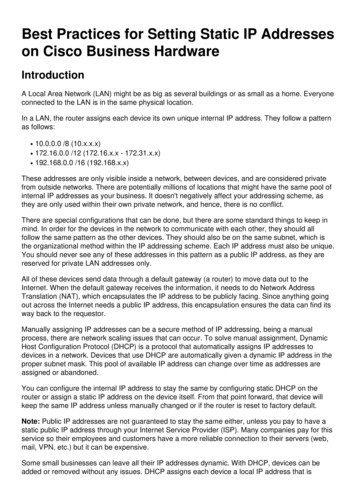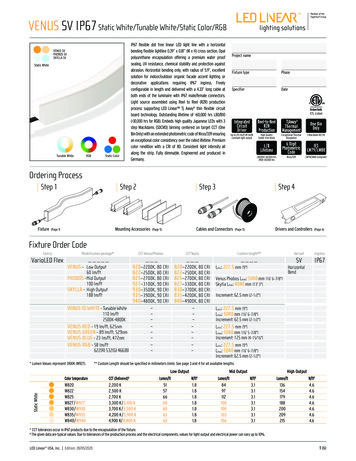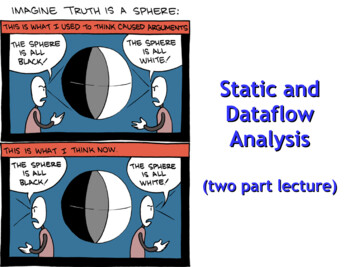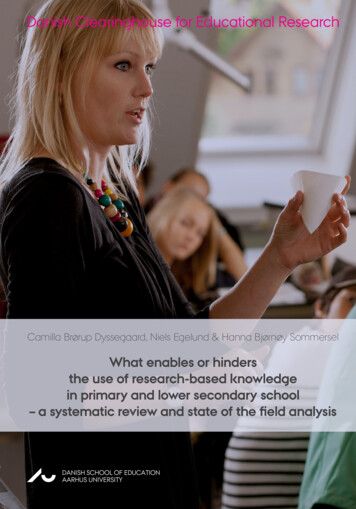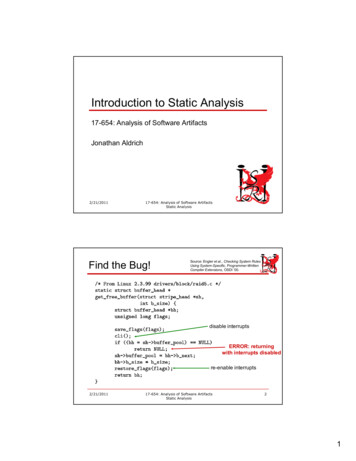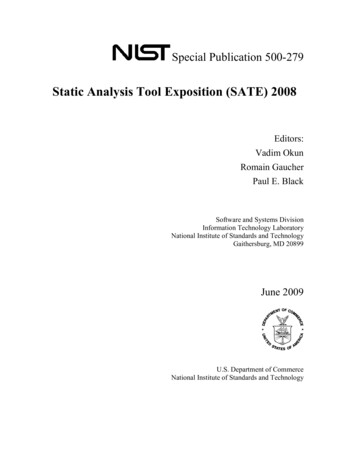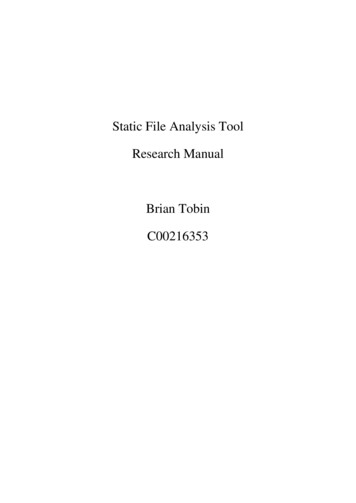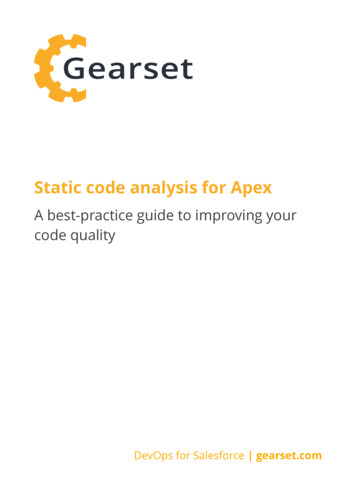
Transcription
Static Program AnalysisAnders Møller and Michael I. SchwartzbachFebruary 10, 2022
Copyright 2008–2021 Anders Møller and Michael I. SchwartzbachDepartment of Computer ScienceAarhus University, DenmarkThis work is licensed under the Creative Commons Attribution-NonCommercialNoDerivatives 4.0 International License. To view a copy of this license, 4.0/.
ContentsPrefacev1Introduction1.1 Applications of Static Program Analysis . . . . . . . . . . . . . .1.2 Approximative Answers . . . . . . . . . . . . . . . . . . . . . . .1.3 Undecidability of Program Correctness . . . . . . . . . . . . . .11362A Tiny Imperative Programming Language2.1 The Syntax of TIP . . . . . . . . . . . . .2.2 Example Programs . . . . . . . . . . . .2.3 Normalization . . . . . . . . . . . . . . .2.4 Abstract Syntax Trees . . . . . . . . . . .2.5 Control Flow Graphs . . . . . . . . . . .9913141516Type Analysis3.1 Types . . . . . . . . . . . . . . . . . .3.2 Type Constraints . . . . . . . . . . .3.3 Solving Constraints with Unification3.4 Record Types . . . . . . . . . . . . . .3.5 Limitations of the Type Analysis . .192022252933.3737384143Dataflow Analysis with Monotone Frameworks5.1 Sign Analysis, Revisited . . . . . . . . . . . . . . . . . . . . . . .5.2 Constant Propagation Analysis . . . . . . . . . . . . . . . . . . .5.3 Fixed-Point Algorithms . . . . . . . . . . . . . . . . . . . . . . . .51525758345.Lattice Theory4.1 Motivating Example: Sign Analysis . . . .4.2 Lattices . . . . . . . . . . . . . . . . . . . .4.3 Constructing Lattices . . . . . . . . . . . .4.4 Equations, Monotonicity, and Fixed Pointsi.
dening6.1 Interval Analysis . . . . . . . . . . . . . . . . . . . . . . . . . . .6.2 Widening and Narrowing . . . . . . . . . . . . . . . . . . . . . .7979827Path Sensitivity and Relational Analysis7.1 Control Sensitivity using Assertions . . . . . . . . . . . . . . . .7.2 Paths and Relations . . . . . . . . . . . . . . . . . . . . . . . . . .8990918Interprocedural Analysis8.1 Interprocedural Control Flow Graphs . . . . . .8.2 Context Sensitivity . . . . . . . . . . . . . . . . .8.3 Context Sensitivity with Call Strings . . . . . . .8.4 Context Sensitivity with the Functional Approach.99. . . . 99. . . . 103. . . . 104. . . . 107Control Flow Analysis9.1 Closure Analysis for the λ-calculus . . . . .9.2 The Cubic Algorithm . . . . . . . . . . . . .9.3 TIP with First-Class Function . . . . . . . .9.4 Control Flow in Object Oriented Languages9Live Variables Analysis . . . . . . . .Available Expressions Analysis . . .Very Busy Expressions Analysis . . .Reaching Definitions Analysis . . . .Forward, Backward, May, and MustInitialized Variables Analysis . . . .Transfer Functions . . . . . . . . . .111. 111. 114. 116. 12010 Pointer Analysis10.1 Allocation-Site Abstraction . . . .10.2 Andersen’s Algorithm . . . . . .10.3 Steensgaard’s Algorithm . . . . .10.4 Interprocedural Pointer Analysis10.5 Null Pointer Analysis . . . . . . .10.6 Flow-Sensitive Pointer Analysis .10.7 Escape Analysis . . . . . . . . . .12312312412913113213513711 Abstract Interpretation11.1 A Collecting Semantics for TIP11.2 Abstraction and Concretization11.3 Soundness . . . . . . . . . . . .11.4 Optimality . . . . . . . . . . . .11.5 Completeness . . . . . . . . . .11.6 Trace Semantics . . . . . . . . .139139145152158160166Index of Notation.171
CONTENTSBibliographyiii173
PrefaceStatic program analysis is the art of reasoning about the behavior of computerprograms without actually running them. This is useful not only in optimizingcompilers for producing efficient code but also for automatic error detectionand other tools that can help programmers. A static program analyzer is a program that reasons about the behavior of other programs. For anyone interestedin programming, what can be more fun than writing programs that analyzeprograms?As known from Turing and Rice, all nontrivial properties of the behaviorof programs written in common programming languages are mathematicallyundecidable. This means that automated reasoning of software generally mustinvolve approximation. It is also well known that testing, i.e. concretely runningprograms and inspecting the output, may reveal errors but generally cannotshow their absence. In contrast, static program analysis can – with the right kindof approximations – check all possible executions of the programs and provideguarantees about their properties. One of the key challenges when developingsuch analyses is how to ensure high precision and efficiency to be practicallyuseful. For example, nobody will use an analysis designed for bug finding ifit reports many false positives or if it is too slow to fit into real-world softwaredevelopment processes.These notes present principles and applications of static analysis of programs. We cover basic type analysis, lattice theory, control flow graphs, dataflowanalysis, fixed-point algorithms, widening and narrowing, path sensitivity, relational analysis, interprocedural analysis, context sensitivity, control flow analysis,several flavors of pointer analysis, and key concepts of semantics-based abstractinterpretation. A tiny imperative programming language with pointers andfirst-class functions is subjected to numerous different static analyses illustratingthe techniques that are presented.We take a constraint-based approach to static analysis where suitable constraintsystems conceptually divide the analysis task into a front-end that generatesconstraints from program code and a back-end that solves the constraints toproduce the analysis results. This approach enables separating the analysisv
viPrefacespecification, which determines its precision, from the algorithmic aspects thatare important for its performance. In practice when implementing analyses, weoften solve the constraints on-the-fly, as they are generated, without representingthem explicitly.We focus on analyses that are fully automatic (i.e., not involving programmer guidance, for example in the form of loop invariants or type annotations)and conservative (sound but incomplete), and we only consider Turing complete languages (like most programming languages used in ordinary softwaredevelopment).The analyses that we cover are expressed using different kinds of constraintsystems, each with their own constraint solvers: term unification constraints, with an almost-linear union-find algorithm, conditional subset constraints, with a cubic-time algorithm, and monotone constraints over lattices, with variations of fixed-point solvers.The style of presentation is intended to be precise but not overly formal.The readers are assumed to be familiar with advanced programming languageconcepts and the basics of compiler construction and computability theory.The notes are accompanied by a web site that provides lecture slides, animplementation (in Scala) of most of the algorithms we cover, and additionalexercises:https://cs.au.dk/ amoeller/spa/
Chapter 1IntroductionStatic program analysis aims to automatically answer questions about the possible behaviors of programs. In this chapter, we explain why this can be usefuland interesting, and we discuss the basic characteristics of analysis tools.1.1Applications of Static Program AnalysisStatic program analysis has been used since the early 1960’s in optimizing compilers. More recently, it has proven useful also for bug finding and verificationtools, and in IDEs to support program development. In the following, we givesome examples of the kinds of questions about program behavior that arise inthese different applications.Analysis for program optimization Optimizing compilers (including just-intime compilers in interpreters) need to know many different properties of theprogram being compiled, in order to generate efficient code. A few examples ofsuch properties are: Does the program contain dead code, or more specifically, is function funreachable from main? If so, the code size can be reduced. Is the value of some expression inside a loop the same in every iteration?If so, the expression can be moved outside the loop to avoid redundantcomputations. Does the value of variable x depend on the program input? If not, it couldbe precomputed at compile time. What are the lower and upper bounds of the integer variable x? The answermay guide the choice of runtime representation of the variable. Do p and q point to disjoint data structures in memory? That may enableparallel processing.
21 INTRODUCTIONAnalysis for program correctness The most successful analysis tools that havebeen designed to detect errors (or verify absence of errors) target generic correctness properties that apply to most or all programs written in specific programming languages. In unsafe languages like C, such errors sometimes lead tocritical security vulnerabilities. In more safe languages like Java, such errors aretypically less severe, but they can still cause program crashes. Examples of suchproperties are: Does there exist an input that leads to a null pointer dereference, divisionby-zero, or arithmetic overflow? Are all variables initialized before they are read? Are arrays always accessed within their bounds? Can there be dangling references, i.e., use of pointers to memory that hasbeen freed? Does the program terminate on every input? Even in reactive systems suchas operating systems, the individual software components, for exampledevice driver routines, are expected to always terminate.Other correctness properties depend on specifications provided by the programmer for the individual programs (or libraries), for example: Are all assertions guaranteed to succeed? Assertions express programspecific correctness properties that are supposed to hold in all executions. Is function hasNext always called before function next, and is open alwayscalled before read? Many libraries have such so-called typestate correctnessproperties. Does the program throw an ActivityNotFoundException or aSQLiteException for some input?With web and mobile software, information flow correctness properties havebecome extremely important: Can input values from untrusted users flow unchecked to file systemoperations? This would be a violation of integrity. Can secret information become publicly observable? Such situations areviolations of confidentiality.The increased use of concurrency (parallel or distributed computing) and eventdriven execution models gives rise to more questions about program behavior: Are data races possible? Many errors in multi-threaded programs arecaused by two threads using a shared resource without proper synchronization. Can the program (or parts of the program) deadlock? This is often aconcern for multi-threaded programs that use locks for synchronization.
1.2 APPROXIMATIVE ANSWERS3Analysis for program development Modern IDEs perform various kinds ofprogram analysis to support debugging, refactoring, and program understanding. This involves questions, such as: Which functions may possibly be called on line 117, or conversely, wherecan function f possibly be called from? Function inlining and other refactorings rely on such information. At which program points could x be assigned its current value? Can thevalue of variable x affect the value of variable y? Such questions often arisewhen programmers are trying to understand large codebases and duringdebugging when investigating why a certain bug appears. What types of values can variable x have? This kind of question oftenarises with programming languages where type annotations are optionalor entirely absent, for example OCaml, JavaScript, or Python.1.2Approximative AnswersRegarding correctness, programmers routinely use testing to gain confidencethat their programs work as intended, but as famously stated by Dijkstra [Dij70]:“Program testing can be used to show the presence of bugs, but never to show theirabsence.” Ideally we want guarantees about what our programs may do for allpossible inputs, and we want these guarantees to be provided automatically, thatis, by programs. A program analyzer is such a program that takes other programsas input and decides whether or not they have a certain property.Reasoning about the behavior of programs can be extremely difficult, evenfor small programs. As an example, does the following program code terminateon every integer input n (assuming arbitrary-precision integers)?while (n 1) {if (n % 2 0) // if n is even, divide it by twon n / 2;else // if n is odd, multiply by three and add onen 3 * n 1;}In 1937, Collatz conjectured that the answer is “yes”. As of 2020, the conjecturehas been checked for all inputs up to 268 , but nobody has been able to prove itfor all inputs [Roo19].Even straight-line programs can be difficult to reason about. Does the following program output true for some integer inputs?x input; y input; z input;output x*x*x y*y*y z*z*z 42;
41 INTRODUCTIONThis was an open problem since 1954 until 2019 when the answer was foundafter over a million hours of computing [BS19].Rice’s theorem [Ric53] is a general result from 1953 which informally statesthat all interesting questions about the input/output behavior of programs(written in Turing-complete programming languages1 ) are undecidable. This iseasily seen for any special case. Assume for example the existence of an analyzerthat decides if a variable in a program has a constant value in any execution. Inother words, the analyzer is a program A that takes as input a program T , oneof T ’s variables x, and some value k, and decides whether or not x’s value isalways equal to k whenever T is executed.A(T, x, k)yesIs the value of variable xalways equal to k whenT is executed?noWe could then exploit this analyzer to also decide the halting problem byusing as input the following program where TM(j) simulates the j’th Turingmachine on empty input:x 17; if (TM(j)) x 18;Here x has a constant value 17 if and only if the j’th Turing machine does nothalt on empty input. If the hypothetical constant-value analyzer A exists, thenwe have a decision procedure for the halting problem, which is known to beimpossible [Tur37].At first, this seems like a discouraging result, however, this theoretical resultdoes not prevent approximative answers. While it is impossible to build ananalysis that would correctly decide a property for any analyzed program, it isoften possible to build analysis tools that give useful answers for most realisticprograms. As the ideal analyzer does not exist, there is always room for buildingmore precise approximations (which is colloquially called the full employmenttheorem for static program analysis designers).Approximative answers may be useful for finding bugs in programs, whichmay be viewed as a weak form of program verification. As a case in point,consider programming with pointers in the C language. This is fraught withdangers such as null dereferences, dangling pointers, leaking memory, andunintended aliases. Ordinary compilers offer little protection from pointer errors.Consider the following small program which may perform every kind of error:int main(int argc, char *argv[]) {if (argc 42) {char *p,*q;p NULL;printf("%s",p);1 Fromthis point on, we only consider Turing complete languages.
1.2 APPROXIMATIVE ANSWERS5q (char *)malloc(100);p q;free(q);*p ’x’;free(p);p (char *)malloc(100);p (char *)malloc(100);q p;strcat(p,q);assert(argc 87);}}Standard compiler tools such as gcc -Wall detect no errors in this program.Finding the errors by testing might miss the errors (for this program, no errorsare encountered unless we happen to have a test case that runs the programwith exactly 42 arguments). However, if we had even approximative answersto questions about null values, pointer targets, and branch conditions thenmany of the above errors could be caught statically, without actually runningthe program.Exercise 1.1: Describe all the pointer-related errors in the above program.Ideally, the approximations we use are conservative (or safe), meaning that allerrors lean to the same side, which is determined by our intended application.As an example, approximating the memory usage of programs is conservative ifthe estimates are never lower than what is actually possible when the programsare executed. Conservative approximations are closely related to the conceptof soundness of program analyzers. We say that a program analyzer is sound ifit never gives incorrect results (but it may answer maybe). Thus, the notion ofsoundness depends on the intended application of the analysis output, whichmay cause some confusion. For example, a verification tool is typically calledsound if it never misses any errors of the kinds it has been designed to detect, butit is allowed to produce spurious warnings (also called false positives), whereasan automated testing tool is called sound if all reported errors are genuine, butit may miss errors.Program analyses that are used for optimizations typically require soundness.If given false information, the optimization may change the semantics of theprogram. Conversely, if given trivial information, then the optimization fails todo anything.Consider again the problem of determining if a variable has a constant value.If our intended application is to perform constant propagation optimization,then the analysis may only answer yes if the variable really is a constant andmust answer maybe if the variable may or may not be a constant. The trivialsolution is of course to answer maybe all the time, so we are facing the engineeringchallenge of answering yes as often as possible while obtaining a reasonable
61 INTRODUCTIONanalysis performance.A(T, x, k)yes, definitely!Is the value of variable xalways equal to k whenT is executed?maybe, don’t knowIn the following chapters we focus on techniques for computing approximations that are conservative with respect to the semantics of the programminglanguage. The theory of semantics-based abstract interpretation presented inChapter 11 provides a solid mathematical framework for reasoning about analysis soundness and precision. Although soundness is a laudable goal in analysisdesign, modern analyzers for real programming languages often cut corners bysacrificing soundness to obtain better precision and performance, for examplewhen modeling reflection in Java [LSS 15].1.3Undecidability of Program Correctness(This section requires familiarity with the concept of universal Turing machines;it is not a prerequisite for the following chapters.)The reduction from the halting problem presented above shows that somestatic analysis problems are undecidable. However, halting is often the least ofthe concerns programmers have about whether their programs work correctly.For example, if we wish to ensure that the programs we write cannot crash withnull pointer errors, we may be willing to assume that the programs do not alsohave problems with infinite loops.Using a diagonalization argument we can show a very strong result: It isimpossible to build a static program analysis that can decide whether a givenprogram may fail when executed. Moreover, this result holds even if the analysisis only required to work for programs that halt on all inputs. In other words, thehalting problem is not the only obstacle; approximation is inevitably necessary.If we model programs as deterministic Turing machines, program failurecan be modeled using a special fail state.2 That is, on a given input, a Turingmachine will eventually halt in its accept state (intuitively returning “yes”), inits reject state (intuitively returning “no”), in its fail state (meaning that thecorrectness condition has been violated), or the machine diverges (i.e., neverhalts). A Turing machine is correct if its fail state is unreachable.We can show the undecidability result using an elegant proof by contradiction. Assume P is a program that can decide whether or not any given totalTuring machine is correct. (If the input to P is not a total Turing machine, P ’soutput is unspecified – we only require it to correctly analyze Turing machinesthat always halt.) Let us say that P halts in its accept state if and only if the2 Technically, we here restrict ourselves to safety properties; liveness properties can be addressedsimilarly using other models of computability.
71.3 UNDECIDABILITY OF PROGRAM CORRECTNESSgiven Turing machine is correct, and it halts in the reject state otherwise. Ourgoal is to show that P cannot exist.If P exists, then we can also build another Turing machine, let us call it M ,that takes as input the encoding e(T ) of a Turing machine T and then builds theencoding e(ST ) of yet another Turing machine ST , which behaves as follows:ST is essentially a universal Turing machine that is specialized to simulate T oninput e(T ). Let w denote the input to ST . Now ST is constructed such that itsimulates T on input e(T ) for at most w moves. If the simulation ends in T ’saccept state, then ST goes to its fail state. It is obviously possible to create ST insuch a way that this is the only way it can reach its fail state. If the simulation doesnot end in T ’s accept state (that is, w moves have been made, or the simulationreaches T ’s reject or fail state), then ST goes to its accept state or its reject state(which one we choose does not matter). This completes the explanation of howST works relative to T and w. Note that ST never diverges, and it reaches its failstate if and only if T accepts input e(T ) after at most w moves. After buildinge(ST ), M passes it to our hypothetical program analyzer P . Assuming that Pworks as promised, it ends in accept if ST is correct, in which case we also let Mhalt in its accept state, and in reject otherwise, in which case M similarly haltsin its reject state.Maccepte(T )construct e(ST )from e(T )e(ST )acceptPrejectrejectWe now ask: Does M accept input e(M )? That is, what happens if we runM with T M ? If M does accept input e(M ), it must be the case that Paccepts input e(ST ), which in turn means that ST is correct, so its fail state isunreachable. In other words, for any input w, no matter its length, ST doesnot reach its fail state. This in turn means that T does not accept input e(T ).However, we have T M , so this contradicts our assumption that M acceptsinput e(M ). Conversely, if M rejects input e(M ), then P rejects input e(ST ), sothe fail state of ST is reachable for some input v. This means that there mustexist some w such that the fail state of ST is reached in w steps on input v, soT must accept input e(T ), and again we have a contradiction. By constructionM halts in either accept or reject on any input, but neither is possible for inpute(M ). In conclusion, the ideal program correctness analyzer P cannot exist.Exercise 1.2: In the above proof, the hypothetical program analyzer P is onlyrequired to correctly analyze programs that always halt. Show how the proofcan be simplified if we want to prove the following weaker property: Thereexists no Turing machine P that can decide whether or not the fail state isreachable in a given Turing machine. (Note that the given Turing machine isnow not assumed to be total.)
Chapter 2A Tiny ImperativeProgramming LanguageWe use a tiny imperative programming language, called TIP, throughout thefollowing chapters. It is designed to have a minimal syntax and yet to contain allthe constructions that make static analyses interesting and challenging. Differentlanguage features are relevant for the different static analysis concepts, so ineach chapter we focus on a suitable fragment of the language.2.1The Syntax of TIPIn this section we present the formal syntax of the TIP language, expressedas a context-free grammar. TIP programs interact with the world simply byreading input from a stream of integers (for example obtained from the user’skeyboard) and writing output as another stream of integers (to the user’s screen).The language lacks many features known from commonly used programminglanguages, for example, global variables, nested functions, objects, and type annotations. We will consider some of those features in exercises in later chapters.Basic ExpressionsThe basic expressions all denote integer values:Int 0 1 -1 2 -2 . . .Id x y z . . .Exp Int Id Exp Exp Exp - Exp Exp * Exp Exp / Exp Exp Exp Exp Exp ( Exp )
102 A TINY IMPERATIVE PROGRAMMING LANGUAGE inputExpressions Exp include integer literals Int and variables (identifiers) Id. Theinput expression reads an integer from the input stream. The comparisonoperators yield 0 for false and 1 for true. Function calls, pointer operations, andrecord operations will be added later.StatementsThe simple statements Stm are familiar:Stm Id Exp ; output Exp ; Stm Stm ? if ( Exp ) { Stm } else { Stm } while ( Exp ) { Stm } ?We use the notation . . . to indicate optional parts. In the conditions weinterpret 0 as false and all other values as true. The output statement writes aninteger value to the output stream.FunctionsA function declaration F contains a function name, a list of parameters, localvariable declarations, a body statement, and a return expression: ?Fun Id ( Id , . . . , Id ) { var Id , . . . , Id ; Stm return Exp; }Function names and parameters are identifiers, like variables. The var blockdeclares a collection of uninitialized local variables. Function calls are an extrakind of expression:Exp . . . Id ( Exp,. . . ,Exp )We sometimes treat var blocks and return instructions as statements.Functions as ValuesWe also allow functions as first-class values. The name of a function can be usedas a kind of variable that refers to the function, and such function values can beassigned to ordinary variables, passed as arguments to functions, and returnedfrom functions.We add a generalized form of function calls (sometimes called computed orindirect function calls, in contrast to the simple direct calls described earlier):Exp . . . Exp ( Exp , . . . , Exp )
2.1 THE SYNTAX OF TIP11Unlike simple function calls, the function being called is now an expressionthat evaluates to a function value. Function values allow us to illustrate themain challenges that arise with methods in object-oriented languages and withhigher-order functions in functional languages.The following example program contains three functions:twice(f, x) {return f(f(x));}inc(y) {return y 1;}main(z) {return twice(inc, z);}In the main function, the inc function is passed as argument to the twice function, which calls the given function twice.PointersTo be able to build data structures and dynamically allocate memory, we introduce pointers:Exp . . . alloc Exp & Id * Exp nullThe first expression allocates a new cell in the heap initialized with the value ofthe given expression and results in a pointer to the cell. The second expressioncreates a pointer to a program variable, and the third expression dereferencesa pointer value (this is also called a load operation). In order to assign valuesthrough pointers we allow another form of assignment (called a store operation):Stm . . . * Exp Exp;In such an assignment, if the expression on the left-hand-side evaluates to apointer to a cell, then the value of the right-hand-side expression is stored inthat cell. Pointers and integers are distinct values, and pointer arithmetic is notpossible.The following example illustrates the various pointer operations:x alloc null;y &x;*x 42;z **y;
122 A TINY IMPERATIVE PROGRAMMING LANGUAGEThe first line allocates a cell initially holding the value null, after the second liney points to the variable x, the third line assigns the value 42 to the cell allocatedin the first line (thereby overwriting the null value), and the fourth line readsthe new value of that cell via two pointer dereferences.RecordsA record is a collection of fields, each having a name and a value. The syntax forcreating records and for reading field values looks as follows:Exp . . . { Id : Exp , . . . , Id : Exp } Exp . IdHere is an example:x {f: 1, g: 2};y x.f;The first line creates a record with two fields: one with name f and value 1, andone with name g and value 2. The second line reads the value of the f field.To update the values of record fields we allow two other forms of assignment, for writing directly to a record held by variable or indirectly via a pointer,respectively:Stm . . . Id . Id Exp ; ( * Exp ) . Id Exp;Consider this example:x {f: 1, g: 2};y &x;x.f 3;(*y).g 4;Here, x holds a record, y holds a pointer to the same record, and the two lastassignments update the values of the fields f and g of the record.Records are passed by value, so, for example, if x holds a record then a simpleassignment z x; copies the record to z. For simplicity, the values of recordfields cannot themselves be records (but they can be, for example, pointers torecords).ProgramsA complete program is just a collection of functions:Prog Fun . . . Fun
2.2 EXAMPLE PROGRAMS13(We sometimes also refer to indivial functions or statements as programs.) Fora complete program, the function named main is the one th
analysis, fixed-point algorithms, widening and narrowing, path sensitivity, tsensitivity,controlflowanalysis, several flavors of pointer analysis, and key concepts of semantics-based abstract interpretation. A tiny imperative programming language with pointers and
